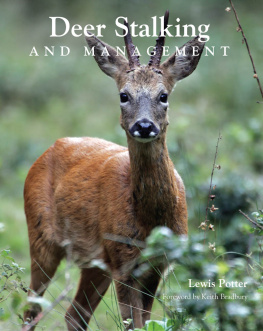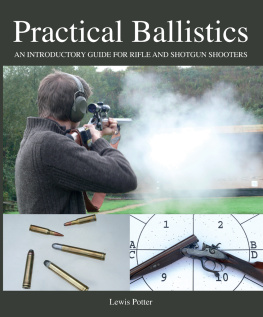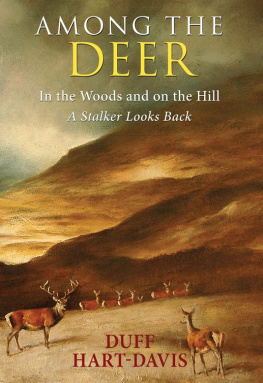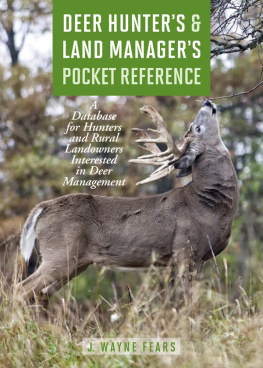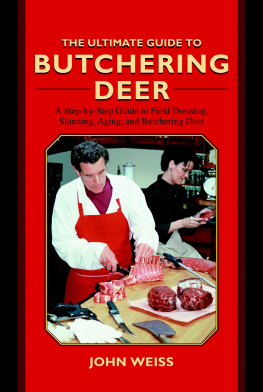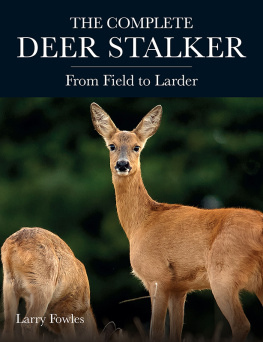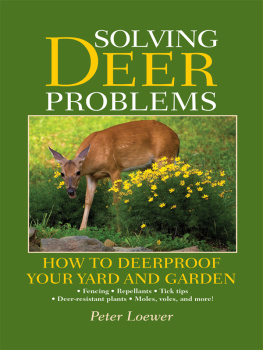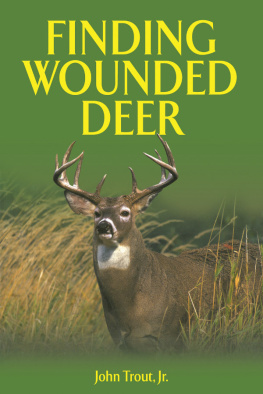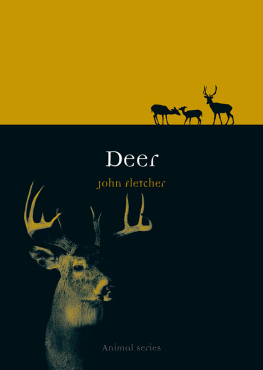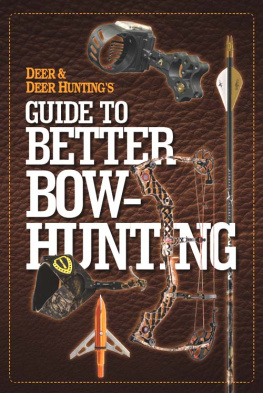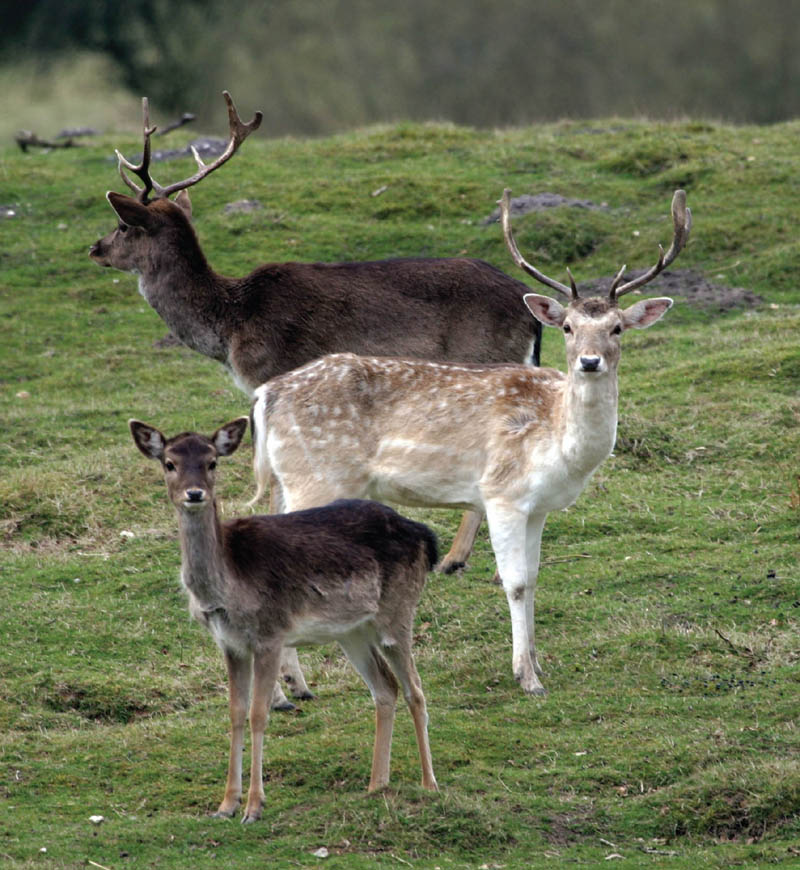
Deer Stalking
AND MANAGEMENT
Lewis Potter
Foreword by Keith Bradbury

THE CROWOOD PRESS
First published in 2008 by
The Crowood Press Ltd
Ramsbury, Marlborough
Wiltshire SN8 2HR
www.crowood.com
This e-book first published in 2014
Lewis Potter 2008
All rights reserved. No part of this publication may be reproduced or transmitted in any form or by any means, electronic or mechanical, including photocopy, recording, or any information storage and retrieval system, without permission in writing from the publishers.
British Library Cataloguing-in-Publication Data
A catalogue record for this book is available from the British Library.
ISBN 978 1 84797 787 8
Disclaimer:
The author and the publisher do not accept any responsibility in any manner whatsoever for any error or omission, or any loss, damage, injury, adverse outcome, or liability of any kind incurred as a result of the use of any of the information contained in this book, or reliance upon it. If in doubt about any aspect of deer stalking and management readers are advised to seek professional advice.
Illustrations are by the author unless otherwise stated.
Frontispiece photograph by Brian Phipps.
Contents
Foreword
I first met Lewis (or Lew, as most friends know him) some twenty years ago when I was working for the Forestry Commission (now Forest Enterprise) as a head ranger. At that time I was dealing with not only wildlife but organizing and running courses in wildlife management for Forestry wildlife staff from all over the UK. I was also assisting with deer stalking courses for the BDS and BASC. I qualified as an assessor and verifier for NVQs and later ran similar courses for Otley Agricultural College.
In 1990, after some years of informal involvement with deer, Lewis came on one of our courses at Cannock Chase to, in his words, see how things are supposed to be done. This was one of the earlier courses that involved not just classroom work, but a high input of practical assessment and marksmanship. It was not very often we had a student using his own make of rifle.
Lewis has already written two successful books: one on beekeeping, another of his hobbies, and recently one on his full-time job of gunsmithing. With this latest book Lewis has attempted to answer a lot of the novice stalkers queries concerning calibres, ammunition and other related matters about firearms. Deer, of course, figure largely in the book, with sections covering species, habits, habitat, management and diseases. I was glad to see the section on ticks and Lyme disease, which highlighted what can be a very nasty disease in humans if not treated quickly.
I am glad he has made the point about always and never, as deer rarely do what you expect and often confound us by doing something completely different to how we expect things to be.
Please enjoy the book and glean everything you can from it: there is a lot of really useful information in these pages. Take note and always strive to be the best stalker and shot the deer deserve only the best. Enjoy your time in the forest and on the hill, taking great care to be safe in all you do.
Keith (Brad) Bradbury
Chief Ranger (retired)
Chilterns, West England Conservancy
and Thetford Forest
Dedication
This book is dedicated to my wife, Sue, who translates my scribble into legible English and tolerates my prolonged absences when I am out with the deer.
Acknowledgements
I thank The Crowood Press for the opportunity to write a book on a subject close to my heart and which has fascinated me for years. Special thanks go to those who generously contributed their time to read parts or all of the manuscript and offered ideas and advice. These include Keith (Brad) Bradbury, who also kindly provided the Foreword, Stuart Burlinson, Patrick Faulkner, Paul Harding, Lawrence Langridge, John Noble and George Wallace.
For help with photographs and various aspects of photography I owe thanks to G. Harry Alderslade, Steve Carter, Keith Bradbury, Tom Braithwaite, Chris Fresson, Paul Harding, Chris Hardy, Mark Howard, Thom Jarman, Kevin Mace and Calvin Crossman (butchers), Roger Nurden, Brian Phipps (wildlife photographer), Nick Ridley (professional photographer), Pierre Shone, and David Stretton (Donington Deer Management).
None of this would have been possible without the help and permission of those landowners whose properties I have been privileged to roam. These include John Child, Gerry Barnett, Mr R. J. Berkeley, Frank and Carol Forbes, Dr Lennox Gregorowski, Mr Michael Fitzgerald, Annette Gorton, Lord and Lady Farnham, Lawrence and Yvonne Langridge, Mr and Mrs John Long, Mr Dennis Winnett and the Greensleeves Shooting Club. I also acknowledge the help and assistance I received from the BASC Deer Department, The Deer Initiative, Brenda Mayle and Dr Robin Gill of Forest Research, Jack Pyke of England, Swarovski UK Ltd and the Tree Council.
Some things are not possible without extra help, so for acting in the male model role I thank Will Teiser and my sons Matt, Dan and Jamie, and also my daughter Lucie for her computer skills.
One person who deserves special thanks is my good friend Adrian Howard who, right from the start, unhesitatingly gave many hours of his own time to help whenever possible, and also his wife Janet, who provided free meals with her usual cheerfulness. I thank you all, and anyone else who might have helped, even in the smallest way, but especially with that vital ingredient: encouragement.
Preface
There is one thing you can be sure of when discussing deer and their habits and behaviour, and that is the words always and never should only be used with considerable caution. Their use may give an authoritative ring to any statement but will rarely be a reflection of all the facts, as nature seldom deals in absolutes.
It is, of course, true that deer have instinctive reactions to certain situations that tend to follow a pattern and each species has behavioural habits sometimes very different to other deer. Even those species with strong herd instincts will, however have individual animals capable of doing the unexpected.
The more one goes out stalking, or just deer watching, the more one realizes that there is so much to learn. No two days are ever quite the same. If one stalked for a lifetime there would always be something new to be learnt. If the words always and never do have a use it is perhaps in the context things may never always be the same.
LASP
2008
Chapter 1
Deer Species
We are most fortunate in the British Isles to have a large and flourishing population of deer living wild and often remarkably close to human habitation. Nowhere else in Europe is there such a variety of deer. In the UK there are six species roaming freely: the truly native red and roe, and the introduced fallow, Japanese sika, muntjac and Chinese water deer. In addition, in parks there are the larger Formosan sika and the Manchurian (of which there may be a few Formosan living a feral existence) and the Pre David deer. Apart from these there is the red/sika hybrid, which is causing considerable concern in some parts of the country as it is in danger of spoiling the true red deer bloodlines. Even reindeer or caribou have been introduced in the north of Scotland, but do not qualify as quarry animals in the UK; they are unusual as the only species where the females carry antlers.

